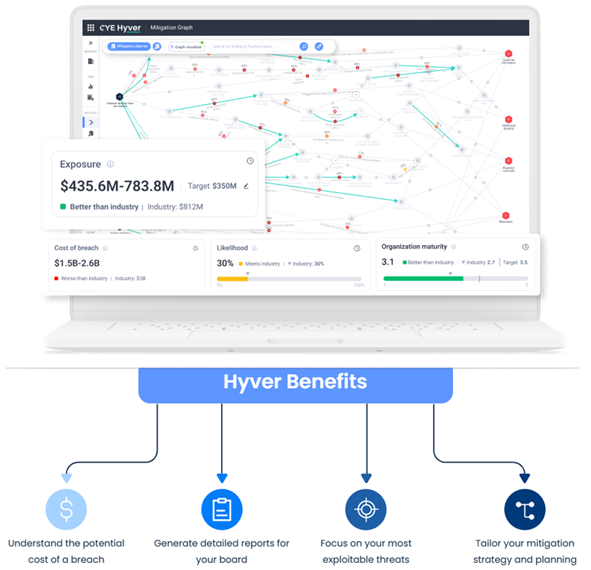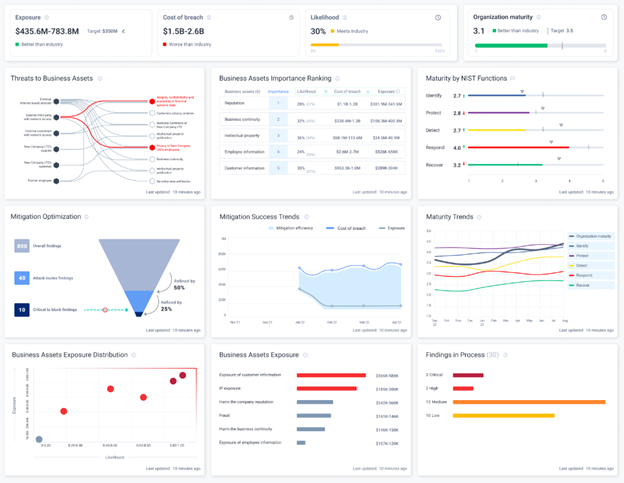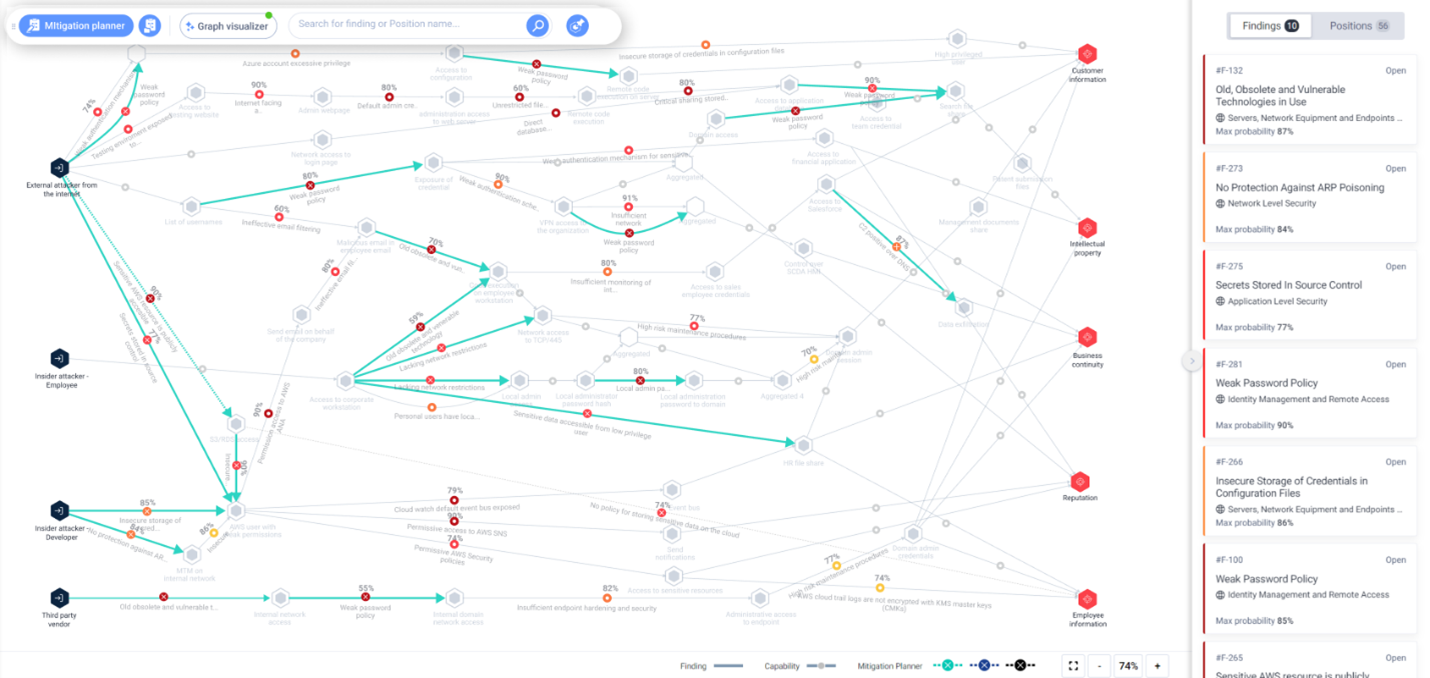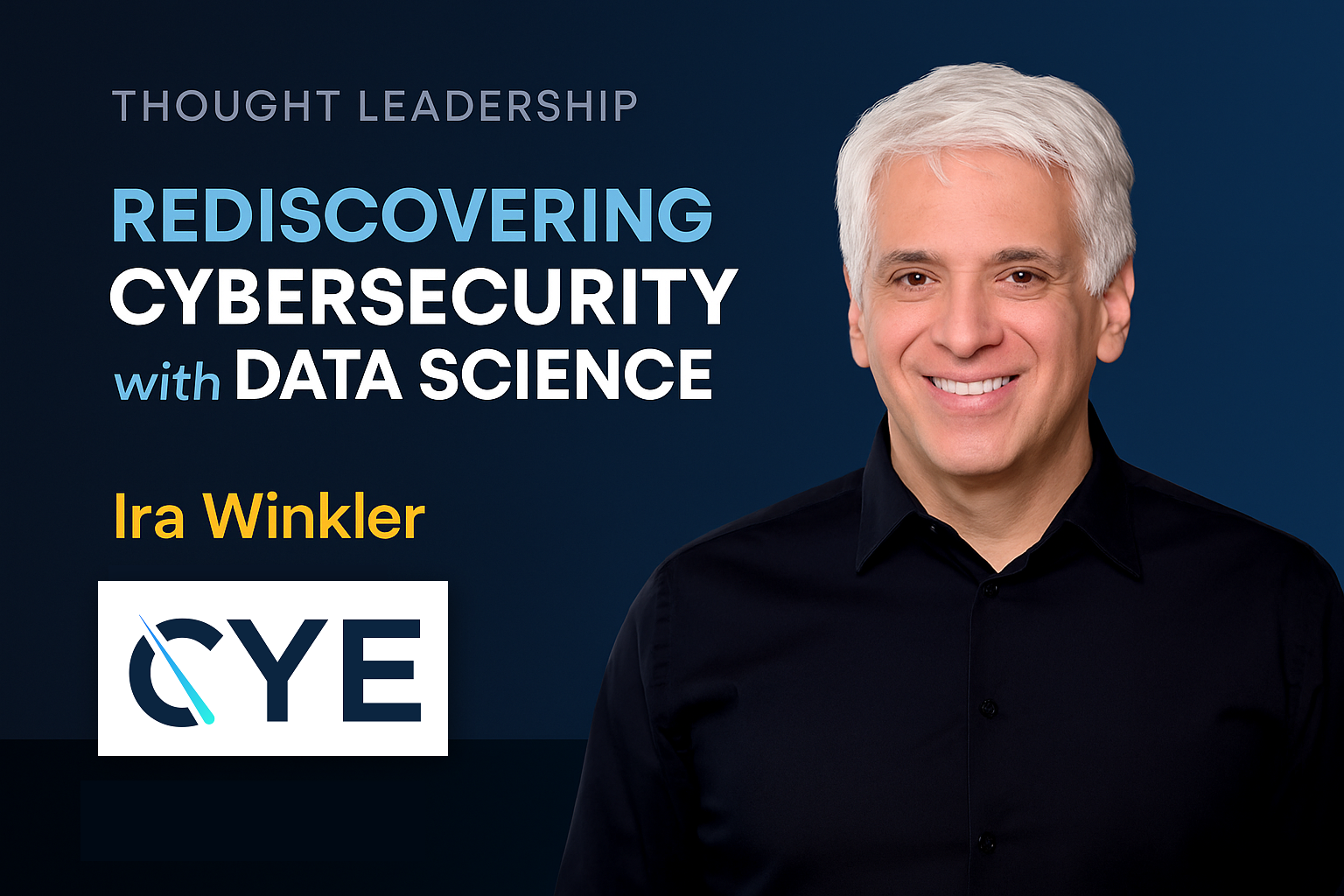A Conversation with Ira Winkler on Turning Cyber Risk into Measurable Business Value Through the Power of Hyver
In a world where cybersecurity is no longer a back-office concern but a boardroom imperative, the need for clear, strategic, and financially aligned cyber risk management has never been greater. CYE stands apart, not just by identifying threats, but by helping organizations understand them in business terms, prioritize them with precision, and mitigate them with measurable impact.
Combining elite cyber intelligence with rigorous data science, CYE has created a new paradigm for cyber exposure management – bridging the gap between security operations and executive accountability. At the heart of this transformation is Hyver, CYE’s cyber decision platform, which quantifies cyber exposure, visualizes attack paths, and matures cybersecurity programs over time.
Today, we speak with CYE’s Field CISO and VP Ira Winkler about bold ideas, data-driven thinking, and strategies that are reshaping how security leaders make decisions, communicate risk, and drive business value.
We encourage readers of this interview to follow Ira Winkler on LinkedIn. He frequently posts insightful articles on critical topics of interest to the cybersecurity community. https://www.linkedin.com/in/irawinkler/

Thought Leadership Interview Questions
- Visionary Origins | CYE was founded at the intersection of cyber warfare and data science. How has that origin shaped your vision for what cybersecurity should look like in enterprise and what’s still missing from how most companies approach it today?
You don’t always think about it, but CISOs and cybersecurity teams often make decisions based on gut instinct. While that instinct is often good, it’s not how other business leaders operate. In other parts of the organization, like operations or finance, leaders rely on data and models to make decisions. When a COO needs to allocate resources, they rely on their operations research team to run the numbers and optimize resources.
The reason is that most business disciplines have adopted data science. Cybersecurity, for the most part, hasn’t – at least not when it comes to strategy. Yes, we use mathematical tools and AI algorithms, but mostly to solve tactical problems.
CYE’s Hyver platform changes that. Hyver transforms cybersecurity from gut-based decisions to data-driven strategies. By applying decision science, it enables CISOs and executives to systematically prioritize investments, ensuring limited resources are deployed where they drive the greatest business impact. Many cybersecurity companies talk about their nation-state hackers. We have those too, but what sets us apart is that we also have nation-state mathematicians and they’re just as important. That’s what drives clarity, scale, and smarter decisions.
- Reimagining Cyber Risk as a Business Metric | The idea of quantifying cyber risk in dollars is revolutionary. How do you see this shifting the conversation between CISOs and the C-suite, and what does it mean for the evolution of cyber as a core business function?
While cyber risk quantification (CRQ) isn’t new, it is limited and often lacks actionable direction. Hyver changes that. Yes, it offers industry-leading CRQ, but it also goes further, applying advanced mathematical models to quantify the business value of each vulnerability and its mitigation options. This enables CISOs to prioritize not just based on CVE scores, but on real business impact and expected ROI.
For example: most organizations prioritize “critical” vulnerabilities based on severity scores. But what if a medium-severity vulnerability exposes a business-critical system, while a higher-severity one affects a sandboxed server with no material value? In reality, not all CVEs carry equal risk.
Hyver helps CISOs look beyond static scoring, using decision science to show where a vulnerability’s business impact justifies action. This ensures that teams focus their efforts where they reduce the most risk and deliver the most value. It’s a shift from generic severity scores to a data-driven, financially grounded approach, turning cybersecurity from a technical issue into a business risk conversation.

Cyber Risk Quantification | Risk Dashboard
- Flipping the Perspective: Think Like an Attacker | One of Hyver’s standout features is its ability to model how a threat actor would reach your most valuable assets. How does adopting an attacker’s mindset reshape how leaders think about security strategy and investment?
I have often criticized the overused cliché: “The good guys have to be right all the time, but the bad guys only have to be right once.” It sounds logical, but it’s not accurate. In reality, an attacker must move through a series of systems, overcoming multiple defenses. That means there are many opportunities to detect and stop them along the way.
At CYE, we have nation-state-level expertise in compromising organizations, and we know it is impossible to implement every possible countermeasure. However, by understanding the attackers’ view, we can identify the best points in the attack path to detect and mitigate threats. We understand where the critical junctions are, those points where intervention will have the greatest impact. Hyver models these attack paths to your most valuable assets, helping leaders focus on the areas that matter most. It’s a powerful and cost-effective approach that helps security teams make the most of limited resources while significantly improving resilience.

- Focus in a Fog of Tools and Alerts | With enterprises drowning in tools and false positives, how do you guide CISOs to step back, recalibrate, and focus on what truly reduces risk? What thought leadership does CYE offer in navigating that complexity? How does the inadequacy of insurance fit into this risk management picture?
I always come back to the importance of applying decision science to focus and recalibrate efforts in cybersecurity. It allows CISOs to cut through the noise – too many tools, constant alerts, false positives, and focus on what truly reduces risk. Most CISOs are chosen for their judgment, but gut instinct isn’t enough when the risks aren’t always obvious. We believe the CISO role should be supported by data science to help make clearer, more informed decisions.
When managing cyber risk, you have four options: avoid it, mitigate it, accept it, or transfer it. In our field, risk transfer usually means cyber insurance. But without the right data, organizations don’t always understand what can be transferred or how much coverage they actually need. CYE analyzed insurance data and found that, on average, companies that suffered a breach were underinsured by more than 300%.
This is where Hyver adds real value. It helps security leaders see the full picture of their exposure and make smarter, more cost-effective decisions about where to reduce risk and how to plan for what can’t be avoided.
- Strategic Remediation: From Reactive to Proactive | Many companies treat vulnerabilities as a checklist. You’ve reframed it as a business priority hierarchy. What’s the philosophy behind that—and how does CYE help companies move from tactical fixes to strategic outcomes? How does CYE utilize AI in keeping ahead of current practices?
The criticality of vulnerability – how easy it is to exploit, isn’t always connected to the actual business impact if it’s exploited. That’s why we believe vulnerabilities shouldn’t be treated as a checklist, but as a business priority. Not every CVE justifies action. You need to evaluate it based on potential loss and return on investment.
CYE helps organizations take this approach by applying decision science and economic modeling. Hyver doesn’t just rank vulnerabilities by severity – it shows which ones matter most to the business. It helps CISOs move from tactical patching to strategic prioritization.
We also use AI to constantly improve how we identify attack paths and evaluate risk in real time. It’s not about chasing every threat but about understanding which ones will truly impact the business and acting accordingly.
- Scaling Cyber Resilience Across Diverse Organizations | You work with both mid-sized companies and global giants. What leadership principles or frameworks does CYE bring to help any organization build scalable, resilient cyber programs—regardless of size or maturity?
At CYE, we follow the NIST Cybersecurity Framework, and we’ve found it to be a highly effective model regardless of company size. Our research shows that more mature organizations tend to experience reduced losses when incidents occur, which reinforces the value of building a structured, scalable program. Hyver helps organizations understand where they stand in their security and maturity journey and shows them the most effective path forward, based on business impact and risk reduction.
It’s ironic that some companies think they’re not ready for Hyver because they’re still early in their journey. But that’s exactly when we can be most helpful. We provide visibility into their current maturity level, security posture, and resource allocation, and help them focus on the areas that will deliver the greatest impact – efficiently and cost-effectively.
- The Maturity Journey as a Competitive Advantage | Hyver enables organizations to benchmark and mature over time. In your view, how should organizations think of cyber maturity not just as compliance—but as a competitive advantage in the digital economy? What’s the role of maturity assessment in this spectrum?
Our data clearly shows that more mature organizations experience fewer incidents, and when incidents do happen, the losses are significantly lower. That’s the case for maturity. When we talk about maturity, we’re not referring to buzzwords. It means there are repeatable processes in place that follow good practices. It’s not about checking a box, it’s about building a cybersecurity program that’s properly implemented, consistently managed, and aligned with the business.
This kind of maturity doesn’t just make programs more predictable – it also helps reduce costs, lower risk, and create a real competitive advantage in the digital economy. That’s why maturity assessment is so important. With Hyver, organizations can measure where they are today, identify the most effective steps to improve over time, and make smarter investments that reduce risk and save money.
- CYE’s Thought Leadership Edge | Looking at the broader cybersecurity landscape, what does CYE know—or do differently—that others don’t? What are the core beliefs driving your leadership in the market today, and into the future?
Admittedly, many people still haven’t heard of CYE, and that’s partly because we’ve chosen to grow with discipline. We’re very intentional about how we invest our resources. That means we may not spend as heavily on marketing as others, but we put our efforts where it matters most: into our technology, our science, and our clients.
We take a data science-driven approach to everything we build. That’s why Hyver delivers such accurate, reliable results. We devote significant effort to making sure our systems produce insights that organizations can trust to guide their most important security decisions. Our core belief is that cybersecurity should be grounded in measurable impact. That’s what sets us apart, and what drives us forward as a company.
- Boardroom Translation: Cyber to Business Language | How does CYE equip CISOs to communicate cyber risk in business terms that resonate with the board and executive leadership? What metrics or insights from Hyver have proven most impactful in board-level discussions—and how do they help CISOs shift from being seen as a cost center to a strategic enabler?
I have said for almost 30 years that the biggest problem in cybersecurity is that CISOs get the budgets they deserve – not the budgets they actually need. And to change that, they have to learn how to deserve what they need. When I saw Hyver for the first time, I immediately thought: this is a tool that helps CISOs do exactly that.
Yes, Hyver can calculate Cyber Risk Quantification (CRQ), but it goes beyond that. It assigns a dollar value to each vulnerability, estimates the cost to mitigate it, and calculates the return on investment. That helps CISOs show real business value, not just technical severity. But even ROI isn’t enough. Just because a vulnerability has a high ROI doesn’t always mean it’s the best place to act.
This is where Hyver’s Attack Path Visualization makes a big difference. It shows the full chain an attacker would need to exploit to reach a critical asset and helps identify the most effective points to break that chain. Instead of spreading resources thin, CISOs can focus on the choke points where one fix can stop an entire attack path. That’s how you optimize budget, communicate risk in business terms, and shift cybersecurity from a cost center to a strategic advantage.
- Proving ROI: Making the Business Case for Cyber Investments | How does CYE help CISOs justify cybersecurity budgets and demonstrate a measurable return on investment? Can you share examples of how customers have used Hyver to prioritize investments and show tangible business outcomes?
CYE has several case studies where clients allowed us to measure the impact of Hyver after implementation. We found that organizations were able to reduce or reallocate their cybersecurity budget, by 20-37%.
As I mentioned earlier, Hyver’s attack path visualization helps identify unnecessary or redundant countermeasures. It also highlights the actions that deliver the highest return on investment. That means organizations can reduce risk by using the same or even fewer resources. CYE is a data science company at its core. Our mathematical models help CISOs shift from gut-based decisions to science-driven planning, just like other business functions. That’s how we help define a smarter, more financially responsible security budget.
- Integration & Actionability: From Insight to Execution | How does Hyver integrate with existing enterprise tech stacks and workflows—and what does the path from insight to action look like? How easy is it for security teams to operate Hyver’s findings without creating friction or alert fatigue?
Integration and actionability are what truly differentiate the Hyver platform from would be competitors. Hyver defines recommended mitigation plans and then integrates with ticketing systems that allow CISOs and their teams to track the progress of the plans. The recommended mitigation plans have costs and level of efforts already defined, so it allows for the design of reasonable plans given available resources. The system tracks the progress through both the completion of tickets as well as the actual integration with operational systems to see if mitigation plans are being implemented, but not properly logged.
Interview Conclusion: Why CISOs Should Take Notice
This conversation with CYE’s leadership reveals more than innovation – it unveils a bold redefinition of what cybersecurity can and should be in today’s enterprise.
CYE isn’t just helping organizations respond to threats – they’re equipping CISOs to lead with confidence, clarity, and measurable impact. By combining nation-state-level threat modeling with financial quantification of cyber risk, CYE turns security into a business decision, not just a technical one.
From mapping attacker paths to assigning dollar values to exposures, and aligning remediation with strategic priorities, CYE empowers security leaders to speak the language of the board, justify investments, and drive enterprise-wide resilience.
For CISOs looking to rise above noise, eliminate guesswork, and lead with precision, CYE offers a clear path forward – where cybersecurity becomes a core driver of business value, reputation, and competitive advantage.
by Yan Ross, Editor-in-Chief, Cyber Defense Magazine


 Yan Ross
Yan Ross